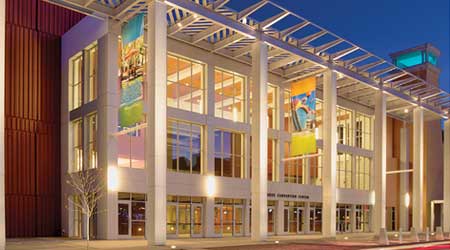 In addition to providing lighting options for a variety of events, lighting upgrades at the Albuquerque Convention Center have delivered annual energy savings of 32 percent.
In addition to providing lighting options for a variety of events, lighting upgrades at the Albuquerque Convention Center have delivered annual energy savings of 32 percent. Upgrade Brings Savings to Light
Lighting upgrades benefit operations and the bottom-line at the Albuquerque Convention Center.
The Albuquerque Convention Center’s star had been dimming a bit. Built in the early 1970s and expanded a decade later, the 230,000-square-foot facility was showing signs of age by 2014. One system in particular needed attention.
“The lighting system was antiquated,” says Tony Gurule, energy and sustainability program manager for the city of Albuquerque. “There was a lot fluorescent technology throughout — some T12s, some first-generation T8s — and there was no control other than an on-off switch.”
Spring forward two years, and the result is a convention center with an upgraded, state-of-the-art lighting system that has enabled managers and staff to meet the needs of conference and meeting planners, as well as brides-to-be. The upgrades also have played a role in driving Albuquerque’s economic growth.
“When you consider the vast number of events that the city of Albuquerque is hosting, a lot of it has to do with the enhanced ability to providing great lighting and a great environment for events to take place,” Gurule says. “The number of events skyrocketed after the east convention center and certainly after the west convention center were upgraded. They have had a huge impact on Albuquerque’s economy.”
Opportunities for savings
Managers and staff with the Albuquerque Convention Center knew the facility was in need of upgrades, in part because the city’s energy-conservation program, which tracked energy use in all of the city’s building assets.
“The convention center fell into a couple of categories,” Gurule says. “One category was top 10 energy users per square-foot. Looking at that matrix alone, we realized that it needed an upgrade.”
The lighting for pedestrian areas around the facility is one example that led to the convention center’s high energy use.
“There is a lot of pedestrian traffic in the morning and in the evening,” Gurule says. “After 8 p.m. in most cases during the week, the pedestrian traffic is limited. In the past, we had fluorescent lighting that remained on in all major corridors, as well as in some of the meeting rooms and conference rooms.”
Jose Garcia, who oversees operations, engineering and maintenance for the convention center, noted several issues that led to the decision to upgrade the lighting system.
“First and foremost was the overall age of the facility, meaning the city hadn’t changed the technology in the facility,” Garcia says. “Second was the new technology and the birth of LEDs. There were more options, as we discovered even throughout the project. The technology was changing and sprinting and becoming more efficient and affordable.
“Third was the man-hours and the cost it took to maintain the system. It was the cost of the light bulbs, the time to change them, light bulbs going out in the middle of an event. Those were the three items that really sped up the conversation and resulted in the project taking place.”
Incorporating operations
Upgrades to both sides of the convention center — the east side in 2014 and the west side in 2016 — included the specification and installation of new LED lamps, troffers, luminaires, and downlights, as well as a new control system.
“I was involved in the initial design elements and the selection process for the fixtures and controls, primarily because at the time I had 20-plus years in lighting and lighting controls and facility management,” Gurule says. “But I wanted to make sure that we took full advantage of getting input from (operations) because they are the folks who ultimately are going to make it successful once implementation took place. We listened to their input in terms of what they wanted the lights to do. We showed them the different lighting options and worked with them to come up with a solid lighting scheme.”
Garcia’s department also played important roles during the upgrades.
“Because this is a convention center and we had events booked, what we had to do is to accommodate all of these spaces while getting the lights done,” Garcia says. “We had to create the opportunities for the work to be done in the meeting rooms and the public spaces. What our maintenance and engineering group did was help the contractor navigate the facility by locating breaker boxes and power sources and those sorts of things. So we accommodated the work, made sure the spaces were available, and assisted the contractor in finding the specific electrical utility rooms that they needed to do their work.”
Garcia emphasized to his team that perhaps most important of all, the upgrade system had to enable the operations staff to meet the lighting needs of customers both large and small.
“We create educational opportunities for associations and corporations, and we have social events, like weddings,” he says. “We needed a product, and we needed a light color that could accommodate both — everything from your standard seminar or meeting to engineers taking a test to a bride and groom having their wedding.”
Related Topics:













